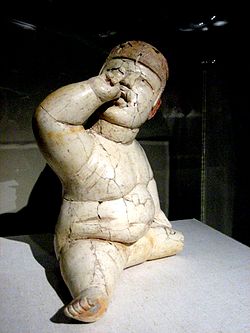
Back Miniatures olmeques Catalan Miniaturas olmecas Spanish Figurine olmèque French Statuina olmeca Italian Olmec figurine SIMPLE Olmekstatyett Swedish Hình nhân Olmec Vietnamese 奥尔梅克雕像 Chinese


Olmec figurines are archetypical figurines produced by the Formative Period inhabitants of Mesoamerica. While not all of these figurines were produced in the Olmec heartland, they bear the hallmarks and motifs of Olmec culture. While the extent of Olmec control over the areas beyond their heartland is not yet known, Formative Period figurines with Olmec motifs were widespread in the centuries from 1000 to 500 BC, showing a consistency of style and subject throughout nearly all of Mesoamerica.
These figurines are usually found in household refuse, ancient construction fill, and, outside the Olmec heartland, graves.[1][2] However, many Olmec-style figurines, particularly those labelled as Las Bocas- or Xochipala-style, were recovered by looters and are therefore without provenance.
The vast majority of figurines are simple in design, often nude or with a minimum of clothing, and made of local terracotta. Most of these recoveries are mere fragments: a head, arm, torso, or a leg.[3] It is thought, based on wooden busts recovered from the water-logged El Manati site, that figurines were also carved from wood, but, if so, none have survived.
More durable and better known by the general public are those figurines carved, usually with a degree of skill, from jade, serpentine, greenstone, basalt, and other minerals and stones.
- ^ Pool, Christopher A. (Apr 2017). Insoll, Timothy (ed.). "Mesoamerica—Olmec Figurines". The Oxford Handbook of Prehistoric Figurines. doi:10.1093/oxfordhb/9780199675616.013.012.
- ^ Cheetham, David (2009). "Early Olmec Figurines from Two Regions: Style as Cultural Imperative" (PDF). University Press of Florida.
- ^ Castro-Leal, p. 143 .
© MMXXIII Rich X Search. We shall prevail. All rights reserved. Rich X Search